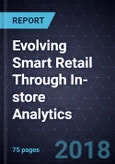Improve Customer Experience with a Data-first Mindset Using In-store Analytics Technology Solutions
Physical retail stores are suffering because of e-commerce and the economics of last-mile logistics. In spite of this, these stores remain the most important touch point for customers. The future of retail involves influencing customers through interactive experiences. Bringing digital content into the retail store and creating stronger interactive customer experience is becoming a reality. To meet the needs of the changing customer, retailers need to also adopt technology to enhance their in-store customer experience.
Future retail needs to integrate aspects of both physical store and e-commerce ("bricks and clicks") formats by leveraging technology to give customers the best shopping experience. With the convergence of various smart technologies, virtualizing of physical objects, giving them an identity, connecting them, and interacting with them to capture data have all been made possible in today’s retail scene.
Online and offline retail experience will be driven by the use of smart technologies. In-store analytic solutions can use a variety of sensors (like Wi-Fi, video, and Bluetooth beacons) to track movements and measure the impact that changes to a store, such as in layout or product assortment, have on customer behavior. The solution will bring the power of online tracking to the physical retail world, including quantifying the success of physical marketing campaigns and understanding the product mix to offer in stores. It will also bring greater convenience to shoppers with the "grab and go" service trending in today’s retail landscape.
It is important for retailers to evaluate and consider the various technology options available in the market to overcome some of the dynamics in the environment to ensure a compelling feature design and sustainable business model. As not all sensors are created equal, the selection of the right sensor depends on the type of data output and human factors which will impact the overall profitability/ efficiency of the business. Different sensor technologies provide stores with differing levels of data granularity.
Using a combination of data provides data awareness both inside and outside the store. Retailers need to have the data-first mindset where the data collected needs to cycle back to gathering data again to validate the process change. Implementing digital awareness and digital immersion in the physical store provides retailers with business insights. In-store sensors, together with analytics, bring the power of consumer tracking in the physical retail realm. It employs the use of various sensors that enables retailers to make data-driven decisions. Data on different types of customer profiles provide retailers with the insights to make strategic and intelligent business decisions that enable them to convert convenient visitors into committed buyers.
Table of Contents
Companies Mentioned (Partial List)
A selection of companies mentioned in this report includes, but is not limited to:
- Cisco Meraki
- NEC
- Philips Lighting
- Qualcomm - Proximity Beacon
- Retail Next
- Zebra








